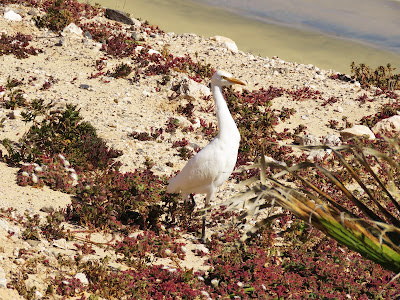Feb 22, 2019
Hike. Antigua to Betancuria, Fuerteventura, February 7, 2019
Antigua and Betancuria are two main towns in the central part of Fuerteventura.
Taking the bus from Costa Calma to Antigua was not easy. Many buses arrived to the bus stop, and there was a lot a people running around. When our bus finally arrived and I was going to pay for my ticket I realized that my valet had been stolen in the bustle and hustle of the bus stop. We then had to go of the bus and try to block my Visa card (in the valet). So, in the end we were delayed more than 3 hours, and it was rather late when we arrived to Antigua in the central part of the island. And it was very late and dark when the bus finally arrived back to Costa Calma.
In the eighteenth-century Antigua was the most prosperous town of Fuerteventura. Antigua was rivaling with the Capital Betancuria, exceeding Betancuria widely in population.
The church in Antigua
Inside the church in Antigua
Lisbeth had a delicious dish with snails in a café just opposite the church in Antigua
The church in Antigua
If one thing in particular defines Antigua’s countryside it is the windmills that break up the flat landscape with the blades, just like bygone times, moved by the gentle, warm, trade winds.
From Antigua to Betancuria we walked at the trail used by the "Pilgrims" walking via the same trail to Vega de Río de Palmas. https://www.wikiloc.com/hiking-trails/von-antigua-nach-vega-de-rio-palmas-10616108
We took the trail used by the "Pilgrims" and reach Betancuria via the path of “la Villa”.
The mountain pass on the pilgrim trail between Antigua and Betancuria
On our way down to Betancuria
On our way down to Betancuria
Some delicious larvae for the waiting fledglings
Betancuria is a small town in the western part of Fuerteventura.
Shrikes are carnivorous passerine birds of the family Laniidae. The family is composed of 31 species
Betancuria is a small town in the western part of Fuerteventura.
Betancuria is named after Jean de Béthencourt, who conquered Fuerteventura from the canarians and founded the town in 1404. It was the original capital of the Kingdom of the Canary Islands, and later capital of Fuerteventura. In 1424 Pope Martin V erected in Betancuria brief Bishopric of Fuerteventura, which encompassed all the Canary Islands except the island of Lanzarote.
The Bishopric of Fuerteventura was abolished only seven years after it was created in 1431. Betancuria was razed by pirates in 1593, but remained capital of Fuerteventura until 1834, when Antigua became capital.
Feb 21, 2019
The trip of the day was to Morro Jable, Fuerteventura, February 6, 2019
Morro Jable is the southernmost town on Fuerteventura, previously a small fishing village now an immense tourist designation. Morro Jable is almost exclusively for German tourists. The beach is the main attraction, with pale golden sand stretching for around 4km from the older part of town. It’s fronted by low-rise, immaculately landscaped apartments and hotels.
Morro Jable Harbour has a regular ferry service taking passengers across to Gran Canaria.
Morro Jable is known for its beaches, like vast Playa del Matorral, with its Lighthouse and the skeleton of a sperm whale
The Morro Jable lighthouse is completed in 1991 and is the tallest lighthouse in the Canaries with a 59m tower.
The landmark of Morro Jable tourist destination is the skeleton of a sperm whale.
A hike along the beach of Costa Calma, Fuerteventura, 05-02-2019
From the hotel I walked to the south to the main beach of Costa Calma south of the hotel the first of a several beaches all the way to the even bigger tourist area near the old fishing town of Morro del Jable.
The main attraction of Costa Calma, and probably the main reason for visiting Costa Calma, is the large, quiet bay with its clean sandy beach. The bay is about 1.5 km long and is the centre of the town.
The town of Costa Calma consists of holiday flats, apartments, hotels, shopping centres and restaurants and is thus a pure holiday resort, built from about 1970. There is no historic town centre. In fact, no real centre is to be found at all.
From our hotel I hiked to the south along Costa Calma beach. "Costa Calma" means "quiet coast"; it is called like this due to its offshore winds and the low waves resulting from them.
Costa Calma. In the background the wind turbines of the wind park near Costa Calma build with EU support. On Fuerteventura, there is a constant wind during the whole year.
The Barbary ground squirrel (Atlantoxerus getulus). It is from the seaward side of the Atlas Mountains and was introduced into the Fuerteventura in 1965. It loves tourists and all the morsels they leave behind them.
Costa Calma is famous for its windsurfering. The wind on this part of the Fuerteventura is very reliable and the windsurf spot here offers some of the cleanest flat water blasting on the whole island.
A view towards our hotel.
The ruddy turnstone is a small wading bird,
Sanderling and ruddy turnstone
Sanderling
One of the beaches south of Costa Calma
The beach at the end of my hike
The cattle egret is a cosmopolitan species of heron found in the tropics, subtropics, and warm-temperate zones.
Arrived to the Rio Calma Hotel at Costa Calma, Fuerteventura 04-02-2019
We had booked our hotel because the travel agent promised a beautiful sea view, and luckily, we got a room with an excellent sea view. The Rio Calma Hotel is a very big, 384-room, hotel with impressive colonial-style architecture and design. The lobby is designed to look like a church. The hotel is situated on a hill and it is visible wherever you go in the area. It is set in tiered, tropical gardens in a slightly secluded location.
'
Subscribe to:
Posts (Atom)











































